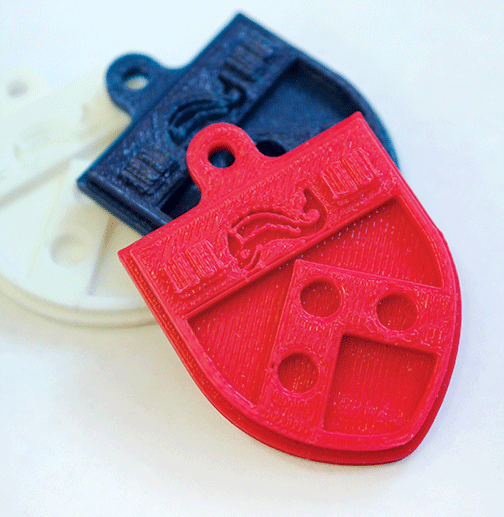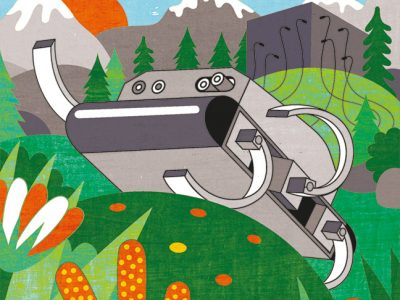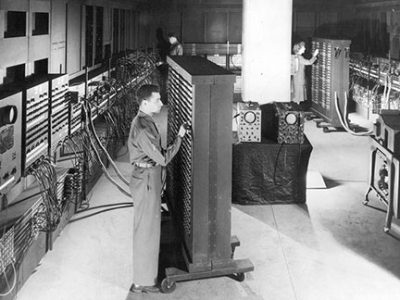
Few knew what the strange black box was at first. It sat there in the front of the room, masquerading as a piece of A/V gear—a projector, perhaps, or an unusual laptop stand. Then its red lights began to glow and someone offered a formal introduction: audience, meet the MakerBot Replicator 2.
A desktop 3D printer that retails for about $2,000, the MakerBot was out for a night on the town at World Café Live in late September. Most people have heard about 3D printing at this point, but relatively few have seen it in action. Hoping to understand the hype, a sizable group came out for a Penn Science Café presentation on 3D printing and its research uses at Penn.
The technique has already been used to build cars, houses, and, in its most adorable application, a small prosthetic leg for a duckling.
Inside the World Café, Nick Parrotta EAS’14 GEng’14, coordinator of instructional laboratories for the School of Engineering and Applied Science, gestured toward the black box beside him. “This is, in the scheme of things, kind of an entry-level 3D printer,” he said. “It’s very consumer-friendly, and has been purposefully constructed to streamline the process, so we figured it’s a good way to introduce you to this.”
Parrotta readied the printer for its assignment: a red, three-dimensional Penn crest, no more than an inch and a half at its widest or longest points and about a quarter-inch thick. He clicked through settings on his computer screen and then explained what the numbers meant: the project would take 13 minutes and require about five grams of “filament.” Like a run-of-the-mill office printer, the machine offered options for low, standard or high-quality output.
Parrotta pressed Print, and as he spoke, the MakerBot began to swipe red material across its work slab, slowly building up the crest, layer by thin horizontal layer. “Basically, what we’re doing is pushing material through a heated extruder nozzle and then laying it down very carefully,” Parrotta said. “You can think of this as a very well-controlled hot-glue gun.”
While the MakerBot continued its labor, Parrotta covered the basics of 3D printing. It’s mainly used for prototypes, manufacturing, and in medicine, he said, offering as examples jewelry, jawbone implants, architectural models, and a rocket engine part. By the time he finished, the MakerBot was done, too. As promised, it had taken exactly 13 minutes to print the Penn crest.
Jonathan Fiene, director of Engineering’s laboratory program, said his students have 24/7 access to the school’s fleet of 10 MakerBots. Some students use the printers to prototype objects or parts, he said—something they’ll later make in metal, for instance, but can’t afford to waste the time and materials on a test model. Others create finished products: a spherical maze, a crane game, funky shells for their flash drives.
“There has been immense demand for the MakerBots,” Parrotta said after the event. “It’s been incredible to see how hungry the students are for that technology. I think they find it very empowering to print their own designs.”
The MakerBots reside in the Rapid Prototyping Lab, while more professional, industrial-grade 3D printers are housed in the AddLab. That new facility includes a ProJet 6000—a refrigerator-sized model that converts liquid print-stock into solid form using ultraviolet lasers—and a significantly smaller device that can print in three colors or materials at once. Parrotta said the AddLab will serve as an “in-house service bureau” for people in the Penn community who need things printed in three dimensions.
Katherine Kuchenbecker, an associate professor of mechanical engineering and applied mechanics and computer and information science, outlined several projects that have sprung from her group in the General Robotics, Automation, Sensing and Perception (GRASP) Lab [“Touching the Virtual Frontier,” July|Aug 2010]. Kuchenbecker focuses on haptics—the science behind humans or robots interacting with the physical world through touch—and her group’s innovations include a cane attachment that alerts blind walkers to head-height obstacles and robotic tools that give surgeons tactile feedback.
“It would take a really long time if we had to wait to make the parts in metal,” she added. “3D printing has vastly accelerated the rate at which we can do research in my lab.”
After Kuchenbecker’s talk, Parrotta approached the MakerBot to “post-process” the Penn crest. “The wonderful thing,” he said, “is that this part is really, really easy. Here I have a standard spatula, and here I have a finished part.” He used the former to separate the latter from the printer’s work surface. “And … ta-da!”
It’s not always that simple, but Parrotta had designed a demo-friendly printout. “We actually went through a number of iterations just a couple days ago,” he said. “As you saw, it only takes 13 minutes to print, so we could work out all the kinks before we went ahead and printed, like, 140 of them.”
The audience applauded as a box stuffed with the Penn-crest keychains made its way around. The crests came in red, white, or blue. They were small, rough to the touch, even jagged-edged in spots. But they were 3D-printed—and that was enough to delight the attendees, who each carefully selected one to take home, examine, and flaunt.
—Molly Petrilla C’06




